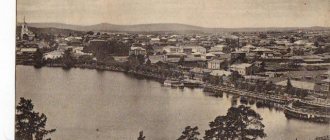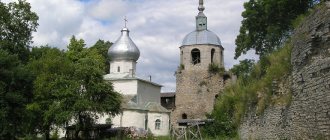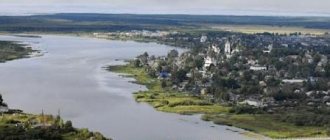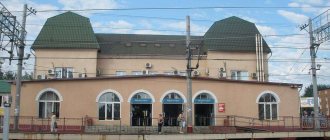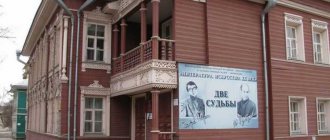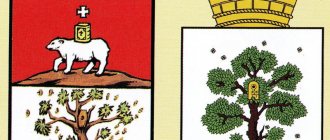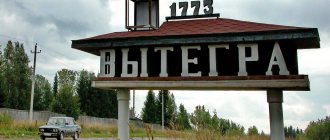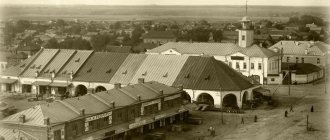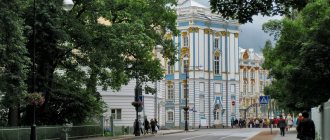Beloozero (Belozersk) is one of the oldest settlements in Russia
.
The official founding date of the city is considered to be 862
, when it was first mentioned in the “Tale of Bygone Years” in the context of the calling of the Varangians-Rus. Many people have repeatedly written about what kind of Varangians they were, and it seems that today the myth about certain foreign Normans has completely exhausted itself. There are no traces of “Vikings” either in the Russian language or in the archaeological finds of the most ancient Russian cities. “Their” Slavic princes were invited from the shores of the Baltic (Polabian Rus') - the same language, culture and origin as us, whose very names are read in Russian (“Rurik”, “Rorik”, “rarog” - in Slavic languages means falcon , which was the symbol of the Rurikovich family later). By the way, one of the centers of this Polabian Rus' was the temple city of Arkona (Rügen Island, Germany), famous precisely for its military traditions - it is not surprising that it was these Western Slavs who were turned to so that they would bring the corresponding knowledge to Eastern Rus'.
I.Glazunov. Gostomysl's grandchildren are Rurik, Truvor, Sineus.
“And three brothers were chosen with their clans and took with them all of Russia, and they came and the eldest Rurik sat in Novgorod, and the other Sineus in Beloozero
, and the third Truvor - in Izborsk... Two years later, Sineus and his brother Truvor died.
And Rurik alone took over all power and began to distribute cities to his husbands—Polotsk to one, Rostov to another, Beloozero to another.
»
How old the city was at that time is unknown, however, it is clear from the wording itself that Sineus came to an already standing city
, and probably one of the largest in the north of Rus' - comparable to Novgorod.
Indeed, in the north-west of White Lake a large Neolithic site
(site Ustye Sholy-1). Since 1964, most of it has gone under water due to the construction of the Volga-Baltic Canal. Many sites of ancient people are located in the southern part of the lake.
However, where was the ancient city of Beloozero itself?
?
The question is far from so simple - the city “moved” from place to place several (!) times
, and even ended up on different shores of White Lake.
It is believed that the “first” Beloozero
was located precisely on the northern shore, then the city moved to the southern shore, namely where the Sheksna River flows from the lake.
Over time, the city grew along both banks of the Sheksna, occupying an area of at least 54 hectares - which makes it one of the largest cities of that time
. Thanks to its advantageous position on water trade routes, it was also one of the richest cities of that time.
The author of the picture is unknown
For some time period Beloozero was a separate principality with its own strong squad
.
, messages
appear every now and then to help this or that prince - so in 1146–1147 Svyatoslav Olgovich sought the help of the Belozersk squad to confront Izyalav Mstislavovich in the fight for the Kiev throne.
And in the monument of ancient Russian literature of the 14th–15th centuries, the famous “Zadonshchina,”
which describes the battle of Dmitry Donskoy with the troops of Mamai at the Battle of Kulikovo,
Belozersk and its princes are mentioned at least 4 times
.
A little bit of history
It is not known for certain when the city was founded. Researchers discovered the first mention of it as the settlement of Beloozero in ancient chronicles in 862. According to some data, the original ruler of the settlement was Sineus, Rurik’s brother. Later, the city came under the control of the third brother - Tuvor, and subsequently - Rurik himself.
In the 11th century, presumably on the initiative of Prince Vladimir, the city of Beloozero was moved to the area of the mouth of the Sheksna River. Here it stood until the 14th century, when it was devastated by the plague and wars with the Novgorodians. The small remaining population was forced to move west along the coast and found a new city, which was given the same name - Beloozero.
In the 19th century, the Mariinsky water system was built on the lake, one of the parts of which was the navigable Belozersky Canal, connecting Kovzha with Sheksna. As a result, trade and economic activity revived both in the city, which by this time had already been renamed Belozersk, and throughout the province. However, the railway that was built quickly seriously weakened the importance of the Mariinsky system. The city again found itself aloof from political and economic life, as well as from the most important communications routes. Belozersk, which had stopped developing, in a short time again became an ordinary quiet provincial town. It remains so to this day.
Belozersky princes in the Battle of Kulikovo. "Zadonshchina"
The first mention is a contrast between the “filthy Mamai” and the “Russian heroes and daredevils.”
The former are presented as
“geese-swans
” (a synonym for sadness, misfortune, deception? read about images of birds in Russian folklore), and the latter -
“falcons, gyrfalcons and hawks”
, but not just any, namely
“Belozersky”(!)
:
Then the geese cackled and the swans beat their wings. No, it was not the geese who cackled and the swans who flapped their wings: it was the filthy Mamai who came to the Russian land and brought his troops.
And their troubles lie in wait for winged birds, soaring under the clouds, crows play incessantly, and jackdaws cackle
in their own way , eagles squawk, wolves howl menacingly and foxes dash - they smell bones.
And already falcons and gyrfalcons and Belozersk hawksthey break from the golden stocks from the stone city of Moscow, they break off the silk fetters, soaring under the blue skies, ringing gilded bells on the fast Don, they want to strike at countless flocks of geese and swans -
then the Russian heroes and daredevils want to strike at the great forces of the filthy Tsar Mamai
.
Ivan Bilibin. Illustration for the epic "Volga".
There are two conclusions to be drawn from this passage. Or Mamai was opposed mainly by the Belozersk princes and squad
, or we are talking about the fact that
the perception of the falcon/gyrfalcon/hawk as a princely bird-symbol is associated specifically with Beloozer and the first princes
(Sineus and Rurik, whose name means “falcon” in various Slavic languages).
The second mention refers to the moment when Dmitry Ivanovich Donskoy tells
to his brother and ally Vladimir Andreevich,
what regiments he brought with him to the Great Don
.
It is noteworthy that the Belozersk princes are first on the list, with the epithet “brave”:
“Brother Vladimir Andreevich! We are two brothers, grandchildren of Grand Duke Vladimir of Kyiv. Our governors have already been appointed - seventy boyars, and the brave princes of Belozersk Fyodor Semenovich and Semyon Mikhailovich
, and Mikula Vasilyevich, and both Olgerdovich brothers, and Dmitry Volynsky, and Timofey Voluevich, and Andrei Serkizovich, and Mikhailo Ivanovich, and the soldiers with us are three hundred thousand men-at-arms..."
Next, Dmitry Donskoy’s troops cross the Don and rush into battle, here again “the whole army ”
identified with
the “Belozersky falcons”
:
Already those falcons and gyrfalcons and Belozersk hawks
They quickly flew across the Don and rushed towards countless flocks of geese and swans.
It was not falcons or gyrfalcons, but the Russian princes flew at the Tatar force
.
Ilya Glazunov. Battle of Kulikovo Field
Finally, assessing the losses after the battle, Dmitry Donskoy asks his men to count “how many governors do we not have and how many young people?”
.
The answer is amazing in that 12 princes of Belozersk are listed
as ... and there are no more princes, the rest are various boyars from other lands. It turns out that only the princes came from Beloozero to the battle, or only the Beloozero princes formed a certain backbone, a striking force, which died in the first place:
“Mr. Grand Duke Dmitry Ivanovich! We don't have
big
Moscow boyars,
twelve Belozersk princes,
Novgorod mayor boyars, twenty
Kolomna
boyars
, forty
Pereyaslav
boyars
Kostroma
boyars
Vladimir boyars, fifty
Suzdal boyars, seventy
Ryazan boyars
, forty boyars , thirty
boyars
, twenty three
Dmitrov
boyars boyars
, fifteen
boyars
. And two hundred and fifty thousand of our entire squad died. And God had mercy on the Russian land, and countless Tatars fell.”
From what I have read, it seems that the Battle of Kulikovo
as such,
it was won in many ways and primarily thanks to the Belozersk princes
and squad...
Attractions on the map
Despite the fact that this city does not have any particular economic or political significance in our time, it certainly remains an important historical center worthy of the attention of researchers and tourists. There really is a lot to see in this ancient Russian city.
The most interesting sights of Belozersk include the Belozersk Kremlin. This unique historical monument of defense architecture was built in the 15th century. during the reign of Prince Ivan III.
In the Kremlin you can see:
Spaso-Preobrazhensky Cathedral, erected in 1670. This majestic structure has the shape of a massive quadruple cube, modestly decorated with traditional narrow blades.
Belozersky earthen rampart. In addition to the Transfiguration Cathedral and some other surviving ancient buildings in the city’s Kremlin, you can see a magnificent example of military architecture of the late 15th century - the earthen rampart - in the past one of the most powerful defensive structures in the north of Russia.
Over the course of several centuries, the embankment, of course, settled significantly. However, Belozersky Val still makes a powerful impression and is a truly picturesque sight.
Particularly distinctive attractions of the city include:
Church of Elijah the Prophet, founded between 1690 and 1696. This religious building was erected outside of Belozersk, but is currently located within its boundaries in the western part. The main part of the temple is a three-tiered tower topped with a large dome with an eight-pointed cross.
Church of the All-Merciful Savior
White Lake. The length of this huge natural reservoir is 46 kilometers, width - 33. The depth in some places can reach up to 6 meters. The lake is home to a huge amount of commercial fish, and its shores are incredibly picturesque.
Beloozersky horizon
On the beach of Beloozero
On White Lake, there is a beautiful pier made of concrete blocks. They are shaped like floats or pears. There is a red warning cone at the end of the pier. To get to the pier, you need to go through the Ilyinskaya crossing, and then to the right towards the lake.
The ancient Belozersky Canal, which is 67 km long and goes around the lake from west to south, is also very interesting to explore. The canal belongs to the Volga-Baltic route. It seems to separate the city from the lake. But its direct purpose is to ensure the safe passage of ships during storms on the lake. The only place where you can cross the canal is the Ilyinskaya pontoon crossing. If you are traveling by car, you can drive through it to get to the lake shore. And local residents get to the beach through it.
Obvodny Canal and Belozersk Embankment
Ilyinskaya crossing across the Belozersk bypass canal. If you are by car, you can safely drive to the other side to get to the stone pier on the lake
View of the canal from the crossing
Belozersky port workshops
Larik moved to the other side and stood in the parking lot). We park the car in a small parking lot and go to the lake
Crossing again
Path to the pier. We walk along the canal, photographing beautiful houses on the embankment along the way.
Here we are. This is the Belozersk pier. Lightly decorated If you have the desire, you can get to its extreme point, but you have to be careful
This is the Belozersk pier. Lightly decorated If you have the desire, you can get to its extreme point, but you have to be careful
Belozersk
Belozersk (the ancient chronicle name is Beloozero) is one of the most ancient cities in Russia. Now this name hides a quiet, modest provincial town, and in sources under 862 it was mentioned among the three most important centers of Northern Rus'. The city of Belozersk is located on the southern coast of White Lake. But the question is whether it was located here already in the second half of the 9th century. – remains one of the most controversial. City of Sineus
On the very first pages of Russian chronicles, in their introductory, so-called ethnographic part, the authors mention Beloozero and its “first inhabitants” - the entire Finno-Ugric tribe. Along with other miracles and the tribes of the Krivichi and Slovenes of Novgorod, they are all indicated in the Legend of the calling of the Varangians as the initiators of the invitation of princes “from overseas”. In 862, Varangian Rus' - Rurik with his brothers - Sineus and Truvor - arrived in the future North Russian lands. According to the chronicles, Sineus settled in Beloozero. However, two years later, when Sineus died without leaving heirs, power over Beloozer passed to Rurik and “his husbands.”
The paradox is that the next time Russian chronicles mention Beloozero only two centuries later. Naturally, for this reason, some researchers have a version that in the 9th century. the city might not even exist at all. At an earlier time, the chronicler of the 11th century. it was “transferred” to make the basic information of the Tale of Vocation look more believable. But many historians believe that the Legend of the Calling was compiled taking into account local information: the Novgorodians - about Rurik, and the population of Beloozero - about Sineus. Then the question arises: where was Beloozero Sineus located?
Back in 1860, archaeologists carried out the first excavations at the source of the Sheksna from White Lake, in the Old Town tract. This name appeared here no later than the end of the 16th century. Most scientists are convinced that this is where the chronicle Beloozero was located. However, many years of intensive research convincingly indicate that life in this place arose only in the middle of the 10th century.
Attempts were made to find other ancient settlements as the city of Sineus. But none of the archaeological monuments, in terms of size or other important features, allowed us to reasonably identify it with the chronicle Beloozero. In connection with the entry in the chronicle of the Kirillo-Belozersky Monastery that “Sineus sat with us on Kistema,” a hypothesis arose and is still widespread today that Beloozero was originally located on the site of the present Kisnema - on the northern shore of White Lake. And even in some modern works on the history of Russian cities, a tradition has emerged to believe that none other than the Grand Duke of Kiev Vladimir Svyatoslavich was the initiator of the transfer of Beloozero from the northern shore to the southern one. But there are no reports about this in the chronicles. Many scientists are convinced that archaeological confirmation of the existence of Beloozero on the southern shore precisely in the period indicated in the chronicle - 862 - is only a matter of future research.
Rise of the Magi
In the 10th century, using its advantageous geographical position - on the route of trade routes, Beloozero, of course, already became a major economic center in the north of Rus'. Throughout the 10th and most of the 11th centuries, power over Beloozero firmly belonged to the great princes of Kyiv. But after the death of Yaroslav the Wise in 1054, his three sons - Izyaslav, Svyatoslav and Vsevolod - divided the country. The youngest son, Vsevolod, as the Novgorod Chronicle reports, inherited Pereyaslavl, Povolozhye, Rostov, Suzdal and Beloozero.
Under 1071, according to the news of the Tale of Bygone Years, Beloozero found itself in the midst of a social explosion that shook the northern and northeastern regions of Ancient Rus' - the famous uprising of the Magi. It all started with a crop failure and famine in the Rostov land, where the wise men came from Yaroslavl. Having provoked the local population into riots, the Magi, at the head of a crowd of at least 300 people, set off along the Volga and Sheksna and came to Beloozero. The chronicle conveys a mysterious and semi-legendary story that wherever the Magi went, they accused “noble wives” of concealing their hoards. The Magi “cut through behind their shoulders” and took out from there who was “hiding” what: bread, honey, fish, furs. And then a lot of “wives” were killed along the Volga and Sheksna.
Already in the 19th century. researchers managed to “decipher” a strange story about women hiding supplies. A complete analogy to it is provided by the rituals characteristic of the Finno-Ugric peoples, for example, among the Mordovians. During a special ritual, women used straps to put bags with something valuable behind their backs, and shamans, approaching from behind, cut these bags and took out what they were looking for. The chronicle story, along with other significant data, contributed to the establishment in science of the belief not in the Slavic, but in the Finnish origin of paganism in Ancient Rus'. And the revolt of the Magi itself began to be interpreted by modern researchers as a social confrontation, not so much of an anti-feudal, but primarily of a religious nature. In the “Description of the City of Beloozero” (XVIII century) there is a message that the inhabitants of Beloozero were pagan, worshiped birch and stone - that is, a cult characteristic of the Finno-Ugric peoples.
Princely voivode Jan Vyshatich, who arrived at the scene of unrest and was collecting “polyudya” from the surrounding lands for the Chernigov prince Gleb Svyatoslavich, killed several wise men with his own hands, and then turned to the Belozersk people: “If you don’t grab the magicians, I won’t leave you for a whole year.” Such a sad prospect had a stronger effect on the residents of Beloozero than the murder of their women by the Magi; they seized the remaining Magi and handed them over to the governor. Needless to say, all the Magi were executed. By the way, some researchers believe that Jan Vyshatich was a very valuable informant for the chronicler Nikon and it was he who told him the local Belozersk legends about Sineus.
Participation in strife
In 1096, the inhabitants of Beloozero were drawn into one of the bloodiest civil strife in the entire history of Rus'. It was perpetrated by the grandchildren of Yaroslav the Wise: on the one hand, Vladimir Vsevolodovich Monomakh (then the prince of Pereyaslavl South and the Rostov-Suzdal land) and his sons Vyacheslav, Mstislav (prince in Novgorod), Izyaslav (prince in Murom), on the other - Oleg, Yaroslav and David Svyatoslavich of Chernigov. The Grand Duke of Kiev Svyatopolk Izyaslavich, who was a cousin of both Monomakh and the Svyatoslavichs, also took part in the struggle for the “new row in Rus'” on the side of Vladimir Monomakh. The Murom prince Izyaslav, having gathered many soldiers in Rostov, Suzdal and Beloozero, set out to meet Oleg, who was already marching. During a fierce battle, Oleg won, Izyaslav was killed. Oleg “drove” the Suzdal and Beloozersky residents. After this, the struggle with renewed vigor unfolded between Oleg and Izyaslav’s brother, Mstislav. The latter was again actively helped by the army from Beloozero. After the capture of Ryazan, in which Oleg “settled,” peace was “created” between the warring parties.
In 1149, according to the chronicles, a severe strife occurred between Novgorod and Suzdal. But local legends connect the clash between the Novgorodians and Suzdalians at this time precisely with Beloozero. Indirectly about the claims and power of the Vladimir-Suzdal land over Beloozero from the end of the 11th century. This is evidenced by numerous seals and bullae found by archaeologists on the territory of old Beloozero.
Not only military contingents, but also the territory of Beloozero more than once became participants in clashes between Vladimir-Suzdal Rus' and its neighbors. Thus, the Patriarchal Chronicle notes that during the campaign of the Novgorod boyar Danslav Lazutinich in 1169, aimed at the Dvina and Zavolochye, it was on the territory of Beloozero that the Novgorodians clashed with the troops of the Vladimir-Suzdal prince Andrei Bogolyubsky. In 1184, a regiment of Belozersk residents under the command of governor Thomas Laskov heroically became famous during the famous, united campaign of the Russian princes led by the Grand Duke of Vladimir Vsevolod the Big Nest against Volga Bulgaria. The Belozersk people then successfully fought both the Volga Bulgarians and their allies the Polovtsians.
In 1208, Vsevolod the Big Nest ordered that Rostov and five other important cities, including Beloozero, be given to his eldest son Konstantin. Later, Beloozero passed to Konstantin’s son, Vasilko Konstantinovich. The chronicles, it must be said, cover in great detail the activities of the Belozersk princes Vasilko and his son Gleb, who played a noticeable role in the political life of the Vladimir-Suzdal land.
Under the yoke
The Mongol-Tatar invasion of Rus' did not directly affect Beloozero. Therefore, the Rostov Bishop Kirill found refuge from the enemy here. In a sense, the establishment of the Tatar yoke even led to the independence of this land. After Batu's invasion of North-Eastern Rus' and the heroic death of Prince Vasilko Konstantinovich in 1238 in the battle on the Sit River, Beloozero became independent from the Rostov principality. It is believed that it was Vasilko’s son, Gleb Vasilkovich (1237–1278), who became the first head of the independent Belozersky principality.
But as soon as Beloozero by the end of the 13th century. became independent from other Russian lands, chronicle news about the Belozersk princes became very rare. Researchers believe that this indicates a decline in the role of the Belozersk princes in the political life of North-Eastern Rus'. Their names are noted, as a rule, in the context of all-Russian events - Moscow’s struggle for the Great Vladimir Table and relations with the Golden Horde.
Prince Belozersky Gleb Vasilkovich, according to the descriptions of the chroniclers, was, of course, an outstanding personality. There is information in the sources that in 1251 he built the first monastery on Beloozero at the mouth of the Sheksna. The prince tried to maintain peaceful, constructive relations with the Tatars, repeatedly traveled to the Horde and returned from there with honors. In 1257, he even got married in the Horde and visited the headquarters of the Great Khan in the capital of the entire Mongol Empire - Karokorum. Gleb Vasilkovich also had to participate in campaigns on the side of the Khan of the Golden Horde. Apparently, his contemporaries already had an ambiguous attitude towards this prince. This is evidenced by the fact that after his death, Bishop Ignatius of Rostov ordered to bury him in the main cathedral - the Church of the Most Pure Mother of God in Rostov, and Kirill, Metropolitan of Kiev and All Rus', canceled this decision and even wanted to excommunicate Ignatius from sacred service for this. The “Description of the City of Beloozero” and the “Chronicle of the Trinity Ustshekhon Monastery” contain a folk legend that Gleb Vasilkovich was not buried in Rostov, but on Beloozero and a stone chapel was erected over his grave.
During the period of Grand Duke Ivan Kalita (1325-1340), the Belozersk principality came under the control of Moscow, although for some time it formally retained its independence. In 1375, after the Tver prince Mikhail Alexandrovich made his last attempt to seize the Grand Duchy of Vladimir, the Belozersk prince Fyodor Romanovich was forced to participate with his regiment in the campaign of the Moscow prince Dmitry Ivanovich to Tver.
A special place in the history of Beloozero is occupied by the participation of its princes and army in the Battle of Kulikovo in 1380. All sources especially noted the courage of the Beloozero people in the fierce battle with the Tatars. Even the exact number of dead Belozersk princes is unknown: different chronicles and “The Tale of the Massacre of Mamayev” give conflicting data - 2, 8, 12, 15. Historians do not doubt the reality of the participation and death in the battle of only Prince Fyodor Romanovich and his son Ivan.
In 1389, Dmitry Ivanovich Donskoy bequeathed Beloozero to his son Andrei. From this time on, the Belozersk principality finally lost its independence and became the inheritance of the Moscow princes.
The Great Mor and two Beloozeros
In 1352, according to the chronicles, a great pestilence swept across the territory of all Rus' - a plague that shook the world in the middle of the 14th century. Countless numbers of people died. Sources noted that there was not a single person left in Beloozero. This gave some historians reason to believe that since 1352 the old city of Beloozero, located at the source of the Sheksna, was abandoned and completely ceased to exist, and 17 km west of the previous one arose a new city with the old name Beloozero, where Belozersk is now located .
However, sources mention the “old town of Belozersky” at the source of the Sheksna before 1398 and they know two Beloozers at the same time - both old and new. At the same time, archaeological research in the new location showed the presence of a princely settlement here back in the 12th century. Be that as it may, the further history of the chronicle Beloozero is already directly connected with modern Belozersk.
Centuries of stability and years of Great Troubles
The 15th–16th centuries were an era of political and economic stability in Beloozero. The Moscow administration paid special attention to this city under Grand Duke Ivan III. According to some sources, in 1480, in anticipation of the invasion of Moscow by the Tatar Khan Akhmat, the wife of the Grand Duke Sophia Paleolog and the princely court took refuge in Beloozero.
In 1487, a powerful fortress was built here to defend the northern borderland of Rus'. Huge earthen ramparts were built, and wooden walls with 8 towers were erected on them, with the height of the entire structure more than 30 meters. Trade and craft settlements began to grow around the Belozersk Kremlin. This was greatly facilitated by the active development of trade, which, taking advantage of its geographical location, Belozersk carried on with neighboring regions. In addition to trade, fishing and iron production were widely developed. The products of Belozersk blacksmiths will be the hallmark of the city for several centuries. Sources count about 19 churches here, which indicates intensive population growth, partly due to the influx from the more southern Russian lands ravaged by the Tatars. In the 16th century Beloozero received broad rights to local self-government.
During difficult times for Russia under Ivan IV the Terrible, Beloozero continued to develop dynamically. Oddly enough, this was facilitated by the inclusion of the city in the oprichnina, and therefore directly belonging to the tsar’s lands. Many disgraced people, disliked by Ivan the Terrible, were in exile here. Even the veche bell from Novgorod was among the sovereign's political opponents. The first and oldest surviving stone building in Beloozero, the Church of the Assumption, built in 1553, is associated with the era of Ivan the Terrible.
During the Time of Troubles, or rather, at its end, in 1612, Beloozero suffered greatly from the outrages of the Polish-Lithuanian invaders. While most of the city army became part of the militia of Minin and Pozharsky and went to liberate Moscow, a large Polish detachment unexpectedly broke through to the north of Rus', and Beloozero became its first victim. Only fifty archers met the enemy. The almost powerful fortress was surrendered without a fight. The city was completely devastated, looted and partially burned, the residents fled. The consequences of the ruin were felt almost until the end of the 17th century.
The era of Peter's changes and the golden age of Catherine
Of course, the influence of Peter’s reforms that began the 18th century. throughout Russia, the residents of Beloozero also felt it. Peter I personally visited here. However, the reforms had the most immediate impact only in management. In 1719, the city became the center of the province, which became part of the St. Petersburg province. It was governed by a magistrate, who consisted mainly of local merchants. Further, throughout the 18th century. There were repeated changes in the system of administrative division, but Beloozero invariably remained the center of a province, district, county. In the last quarter of a century, Beloozero assumed the status of a county town, and in 1877 a significant event occurred: Beloozero was officially renamed Belozersk.
Under Catherine the Great, a master plan for street and block development was developed for Belozersk, as for all cities of the empire. In Catherine's era, stone structures were erected here - bridges, shopping arcades, storey buildings. In 1778, the theological seminary opened its doors, and later - city schools for boys and girls. Even later, a women's gymnasium was created on the basis of the latter.
However, in the 18th century. The economy of Belozersk, in contrast to the sphere of culture and education, was not going through its best times. The reorientation of trade routes to Arkhangelsk deprived the city of the benefits of transit trade and incentives for the development of local industry. As Yu. N. Lubchenkov wrote in his book “Cities of Russia”, at the end of the 18th century. They reported to the Senate: “Belozersk is the worst of all cities.”
Pros of the Mariinsky Theater and disadvantages of the railways
In the 19th century city administrative life was determined by two self-government reforms: the “City Charter” (1785) and the “City Regulations” of 1870 (the latter was introduced in Belozersk in 1872). The Belozersk City Duma, opened in 1813, was entrusted with the management of the city economy, in particular, the improvement of the city, the maintenance of administrative, educational and charitable institutions, the exercise of control over commercial and industrial enterprises, city real estate, and the implementation of fire safety and sanitary instructions. Another important body of city government is the meeting of the city society, which consisted of “city inhabitants.” These included city residents with an income of at least 50 rubles. The meetings resolved issues of the use of city property, and also approved items of city expenses and the introduction of fees.
First half of the 19th century passed in the history of Belozersk under the sign of the Mariinsky water system, which in 1810 connected the Volga basin with the Baltic Sea. The final chord in its construction was the construction in 1843–1846. Belozersky bypass canal, which made it possible to protect ships from storms on White Lake.
The idea of building a bypass canal was born in the local urban society, primarily among the merchants. The merchants wanted to make the city a major transshipment base on the most important route supplying St. Petersburg with bread and other goods. The main initiator of the construction was the honorary citizen of Belozersk and wealthy merchant I. I. Shadrin. Back in 1816–1818, when project documentation was being developed, he petitioned for the construction of a canal through Belozersk. And in 1834, when construction of the canal was suspended, I. I. Shadrin made a lot of efforts to resume work.
Inclusion in the Volga-Baltic route gave a strong impetus to the economic development of the city in the second half of the 19th century. Trade relations with other regions of the country began to develop intensively. This had a particularly positive impact on the development of the logging industry. Its products were delivered by water to St. Petersburg.
The existence of the canal determined the employment structure of the urban population. One of the reports of the city duma noted that the townspeople in general are all engaged in the ship trade: the rich transport goods from Rybinsk to St. Petersburg, and the poor are hired on ships as skippers and workers. And only this trade ensures both the maintenance of their families and the payment of taxes. The employment of Belozersk residents in the shipping industry became so widespread that the city authorities, due to the absence of citizens, were sometimes unable to hold meetings of the city society for a long time. Absences, as a rule, lasted until October and November.
The influence of the Mariinsky Theater affected all aspects of the economic development of Belozersk. If in the first half of the 19th century. in the sources there are rare mentions of several enterprises - a bell factory (1802), a glass factory (1819), a brick factory (1827), then by the beginning of the 1870s. the total number of trading establishments and industrial enterprises exceeded 150. Moreover, hired labor was already used in many plants and factories.
However, Belozersk's heyday was short-lived. In the 70–80s. Rapid railway construction began in Russia. The railway that passed through neighboring (100 km) Cherepovets, connecting St. Petersburg with the Urals and Siberia, negated the economic importance of the Mariinsky system and this, accordingly, had a detrimental effect on the commercial and industrial development of Belozersk.
A researcher of the archives of the Belozersk City Duma, Yu. A. Smirnov wrote about the problems that arose before the city in connection with the advent of the railway, which caused the decline of the ship industry. Report of the mayor on public education for 1885–1889. contained recommendations for citizens. The remoteness of the railways did not allow the development of industry here, and the official recommended training Belozersk people in arable farming, handicrafts and agricultural crafts, as well as women in the proper organization of lace making.
However, the “proper organization of lace making” did not save Belozersk. Finding itself aloof from new routes of communication and connections with other industrial centers, the city finally lost the prospect of becoming an economically significant settlement and turned into a quiet provincial town that was not growing. Zemstvo doctor Sergei Dmitrievich Chechulin (1866–1936), who knew this city well, wrote that Belozersk in 1919 was exactly the same in appearance as in the 1860s. According to the 1897 census, the city's population was 5 thousand people, and by 1917 it increased by only a thousand people.
On the margins of history
Revolutionary storms of the early 20th century. affected Belozersk only to the extent that they could affect a provincial town, deprived of “fuel” for a revolutionary fire - significant masses of the proletariat.
The participation of Belozersk in the Civil War is largely reminiscent of the fate and name of the famous Belozersk infantry regiment. Created under Peter the Great in 1708, it worthily took part in the main military campaigns of Russia - the Northern and Seven Years' Wars, the Russian-Turkish and Russian-Swedish Wars, the Patriotic War of 1812, where it covered itself with unfading glory at Borodino and Maloyaroslavets. During the Crimean War, Malakhov Kurgan was defended. In 1891, the regiment was named the 13th Belozersky Infantry and took part in the battles of the First World War. Having not survived the revolution of 1917, the regiment was revived during the Civil War and was part of many white armies. His story ended in 1920 in the Crimea, sharing the fate of the troops of Baron Wrangel.
In the pre-war years, the heat of industrialization of the first five-year plans passed over Belozersk - there were no Komsomol construction projects here, no industrial giants were erected.
Fortunately for the residents of the city, the Great Patriotic War did not reach Belozersk directly with fighting. Of course, many residents were mobilized into the Red Army and fought on all fronts. The summer of 1941 was remembered by Belozersk residents for the digging of trenches and anti-tank ditches, long caravans of barges with Leningraders evacuated to the east. Then, in August 1941, many refugees from Petrozavodsk were settled in the city due to the offensive of the Finns, allies of Nazi Germany. Winter 1941–1942 military transport aviation began to regularly deliver wounded Red Army soldiers from the Karelian and Tikhvin fronts. Taking off from front-line airfields, the planes landed directly on the ice of White Lake. Hospitals were set up in the city. In the winter of 1942, the half-starved Belozersk residents themselves hospitably welcomed into their homes the soldiers of the Siberian regiments transferred to Tikhvin and the Onega region. After the end of the Great Patriotic War, the residents of Belozersk, like the entire Soviet people, overcame the post-war devastation and were engaged in the restoration of the national economy.
In the post-war period, the city's infrastructure was restored, old enterprises resumed operations and new enterprises appeared. Of course, Belozersk has not become what is called an industrial city, but there are currently several enterprises in the woodworking, light and food industries, dairy production, a printing house, and ship repair shops.
Until recently, the famous Belozersk smelt was industrially mined on White Lake. But in recent years, fishing here has been going through hard times. The city’s coat of arms, the latest version of which was adopted in 2001, also reminds us of the former importance of fishing. It, like the first ancient coat of arms of Belozersk, depicts two sterlets placed crosswise.
In 2000, Belozersk, taking into account the long history of the city and its contribution to the development of trade between Russia and the countries of Northern Europe, was accepted as a member of the honorary Hanseatic Community.
Today the population of Belozersk is less than 10 thousand people. The city is still deprived of railway connections and does not have all the benefits of urban civilization. Not even all areas of the city have running water.
Does the “city of wooden fairy tales” have a future?
Belozersk, the oldest city in Russia, has the main and necessary potential for the development of tourism - a huge number of unique attractions. Today, many miraculously preserved temples are in deplorable condition - they are dilapidated and destroyed. The main obstacle to the development of tourism is the undeveloped road infrastructure. There are no bridges across the Sheksna: in the summer there are ferries, and in the winter the roads are built on ice. Tourist buses arriving at the Kirillo-Belozersky Monastery cannot travel 40 km to Belozersk. Of course, the city needs to “get” into the relevant government programs for tourism development. Of course, the city needs additional funding. But maybe the Belozersk residents themselves should roll up their sleeves and return their city to its former glory. After all, it seems that no one helped the main character of Beloozer - the famous Prince Gleb Vasilkovich - neither Rostov, nor Novgorod, nor Moscow. But it would be worth returning to their company with dignity.
Roman Rabinovich, Ph.D. ist. sciences
, especially for the portal BankGorodov.RU
Other temples and museums
In addition to the Kremlin, the Church of Elijah the Prophet and the lake, there are other attractions in Belozersk that are worthy of attention. For example, you can explore the old wooden church located in the western part of the city on the site where a bloody battle took place in 1696 between the city residents and the Poles-Lithuanians.
The Belozersk Church of the Assumption, erected by order of Ivan the Terrible in 1570, is also very popular among tourists. This large five-domed temple was once decorated with planks. It was rebuilt at the end of the 18th century. Nearby is a small old Church of the Epiphany built in 1787.
The local history museum in Belozersk is definitely worth a visit. Here are collected the most interesting collections of ancient books, seals, icons, works of ancient masters of temple sculpture, war weaving products, ancient Russian painting and much more.
Among other museums, we recommend especially looking at these:
- White Lake Museum
- Fishery Museum
- Russian Izba Museum
- Interactive forge
- Orlov's House Museum
Belozersk: where to eat and where to stay
After a long day, we arrive in the city of Belozersk in the dark, with thoughts only about “where can I sleep and eat here.” Therefore, I begin my review of the final point of the journey with the city’s tourist infrastructure, which is very, very modest. There are much more catering places with a good tourist reputation than decent hotels.
Where to eat in Belozersk upon arrival and with a reserve for tomorrow (from those recommended by travelers and loved by locals):
- Cafe "Ark" (Address: 83B III Internationala str., tel.: +7 (81756) 2-22-94, daily from 10:00 to 23:00)
- Cafe “Podvorye” (Address: Dzerzhinsky str., 16, tel.: +7 (81756) 2-19-19, from 11:00 to 19:00 every day)
- Restaurant "Provintsiya" (Address: Sergeya Orlov str., 12, tel.: +7 (900) 530-60-60, Mon-Thu 10:00-23:00, Fri-Sun 10:00-2: 00, free Wi-Fi)
But the reviews on the accommodation are all negative. Or the indifferent phrase “well, you can sleep here.” But since the plan is only to sleep, since Belozersk itself and the return journey await in the morning, there is no particular desire to be picky.
So, you can sleep in Belozersk:
- Hotel "River Station" (Address: Naberezhnaya str., 80, tel.: +7 (81756) 2-62-62,)
- Hotel "Rus" (Address: Dzerzhinsky str., 18/A, tel.: 8 (817) 562-11-86)
- Guest house "Solnyshko" (Address: Lenin St., 60 A, tel.: +7 (81756) 2-19-15,,)
- Guest complex "Priozerye" (Address: P.K. Georgievskogo Naberezhnaya St., 16A, tel.: +7 (81756) 2-32-23, +7 (921) 128 44 79)
City architecture
Belozersk is distinguished by cleanliness, comfortable amenities and hospitality. On the occasion of the 1150th anniversary of its founding, on the initiative of the administration, a grandiose renovation was carried out in the city: the roads were put in order, the facades of ancient houses were restored, and the embankment was renovated.
On the restored Belozersk embankment in May
There are many cyclists on the embankment
Architecturally, this settlement is actually incredibly beautiful. In addition to the ancient religious monuments and the Kremlin, on the embankment you can admire, for example, ancient picturesque one-story houses built in the mid-19th century. Once upon a time there were barracks, a forge, a canal master's house and other buildings for domestic and economic purposes.
A small chapel in the city center on Dzerzhinsky Street
Shopping arcades of the 19th century
Stone Bridge - the road to the Belozersky Kremlin
In the frame there is a stone bridge and the Belozersk boat - a symbol of the city
It is worth noting that the architecture of the city is mainly one- and two-story buildings. Moreover, both stone and wooden.
These wooden houses are not uncommon on the city streets.


